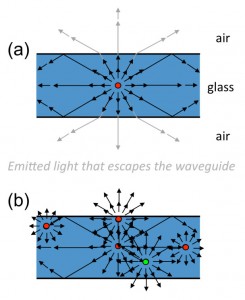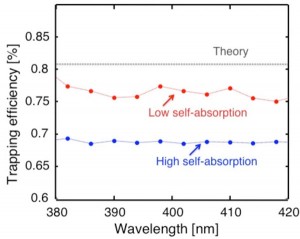Understanding the Role of Self-absorption on the Trapping Efficiency of Luminescent Solar Concentrators
- Category: Energy
- Tags: Carlijn Mulder, Marc Baldo, Philip Reusswig
Luminescent Solar Concentrators (LSCs) aim to reduce the cost of solar electricity by using an inexpensive collector to concentrate solar radiation without mechanical tracking (Figure 1a) [1] . Ideally, the dyes re-emit the absorbed light into waveguide modes that are coupled to solar cells attached to the edges of the collector (black arrows). However, some photons are always lost, re-emitted through the face of the LSC, and coupled out of the waveguide (grey arrows). The trapping efficiency, ηtrap, is defined as the fraction of photons emitted from the edge versus photons emitted from the face and edge combined. Assuming the dyes emit their photons isotropically, ηtrap is given by ηtrap = [latex]\sqrt{1-1/n_5^2}[/latex] . If the refractive index of the waveguide ns is ~ 1.7, then 20% of the re-emitted photons are lost.
Such surface losses become compounded if photons trapped in the waveguide and travelling towards the edges are re-absorbed by other dye molecules in the waveguide; see Figure 1b. When such re-absorbed photons are re-emitted, the LSC will suffer more confinement losses, and the cycle repeats. As the number of re-absorption events increases, the overall efficiency of LSCs drops exponentially.
In this work, we aim to quantify the contribution of self-absorption to the surface losses of an LSC. We vary the amount of self-absorption by tuning the dye concentration of ALq3 and DCJTB in the waveguide (ns = 1.7). Figure 2 shows preliminary results for ηtrap of an LSC with high and low self-absorption. The LSC with low self-absorption has ηtrap of 78%, which approaches the theoretical ηtrap of 81%. The slightly lower measured value of ηtrap is likely to be explained by scattering losses from the LSC surface.
- Figure 1: (a) A schematic representation of a luminescent solar concentrator. The trapping efficiency is defined as the fraction of photons emitted from the edge versus photons emitted from the face and edge combined. (b) Illustration of the compounding effect of self-absorption on the trapping efficiency. The green molecule is the first in the system to absorb light, but the three surrounding red dye molecules can absorb photonsthat are re-emitted. The process continues throughout the waveguide, resulting in further loss from the face.
- Figure 2: The measured trapping efficiency, ηtrap of LSC with low (red dots) and high (blue dots) self-absorption. The dotted line is the theoretical trapping efficiency. This measured ηtrap is the ratio between the measured number of photons emitted from the edge and the total number of photons emitted from the face and edges.
- J. S. Batchelder, A.H. Zewail, and T. Cole, “Luminescent solar concentrators. 2: Experimental and theoretical analysis of their possible efficiencies,”Applied Optics, vol. 20, pp. 3733-3754, Nov. 1981. [↩]

